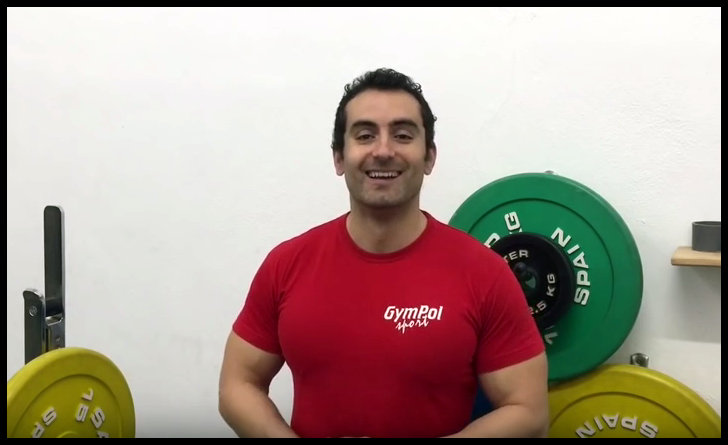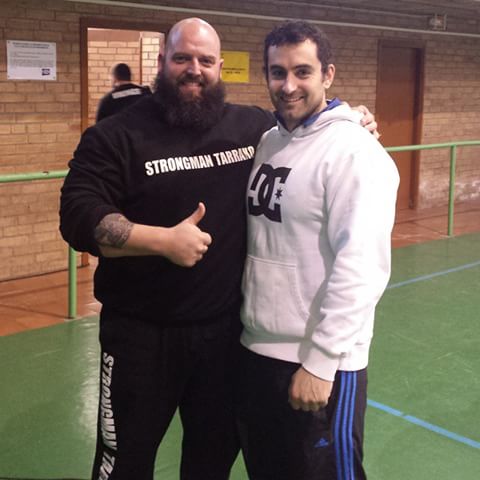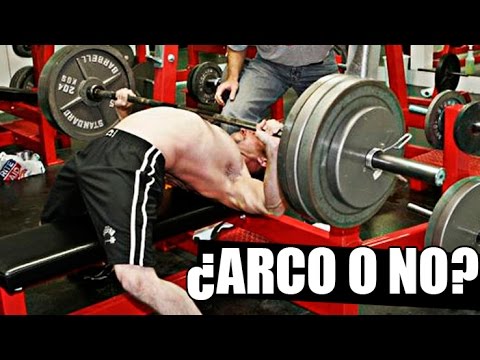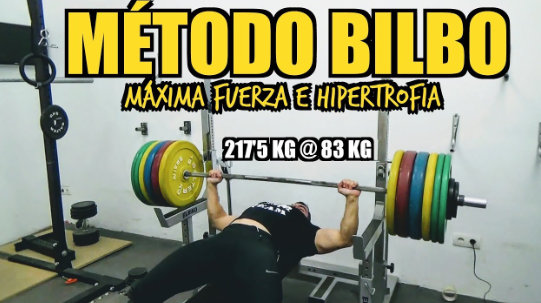"Hypertrophy is training high reps ", " high reps for bulking ", or " high reps are for bodybuilding". How many times have we heard it? There is still a myth that training at high repetitions does not serve to gain strength. It is said that training in this way has always been a thing for bodybuilders in their quest for "muscle pump" and growth. But nothing is further from reality. Today we would like to discuss why that theory might be wrong in practice. And there is nothing better than explaining it with the example of "Bilbo". And no..., we're not talking about Bilbo from The Lord of the Rings, but The Lord of the Bench Press. You want to know more? Read, read...
Bilbo is Jesús Varela, one of the best press benchers in Spain. Some even consider him the best press bencher. With a weight that ranges between 80-86 kg, Varela has taken his maximum bench press to over 200 kilos. This is such an impressive feat that we will rarely see a human perform such a feat of strength. He claims to be natural (he never used doping substances) and that his marks have been the result of his more than 20 years of experience training with weights. But is there something else? How is his training? How did you manage to get 200kg off your chest without being crushed? We tell you...
Bilbo Method: Training at high repetitions
The Bilbo method , which Jesus himself has baptized in reference to his nickname, consists of making the most of a set of high repetitions . That's right, as you hear it. His strength gains from him come from gaining explosiveness by training above 15 reps.
Bilbo himself explains that from a young age he was already good at the bench press. With conventional strength routines of the "3 x 3" or "5 x 5" style, he had maxed out at 300 pounds on the bench press. But he was already carrying a lot of aches and pains as a result of exposing himself to moving heavy loads with low reps. His progress was stagnating and he was finding it harder and harder to reach new milestones. Until he decided to completely change his training style and go high reps. Today, Varela is capable of doing more than 20 reps with those 140 kg of years ago.

Bilbo explains the importance of making each rep as explosive as possible and completing the set in the shortest time possible. To do this, you will use weights far from your maximum mark (1 RM) and you will train in a range that can go from 15 to even 50 repetitions. The premise is that if you are able to exceed your number of reps with a given weight or complete the set in less time, then your record for one rep max will go up as well. If today you have a maximum of 170 and you are able to move 100 kg x 20 repetitions..., when you are able to do 30 reps with 100 kg, then your mark could go up to 200 kilos. If you win high rank, you win low rank too, that's the key.
Jesús Varela proposes that you start each training session making the most of your first set. The first set is called the "Bilbo Set" and is the key to progress. In the Bilbo set, a relatively "low" weight is chosen and the goal is to get the maximum number of repetitions possible. You always have to push quickly and explosively, but avoid traps and rebounds as much as possible. Once the Bilbo set is completed , the number of reps achieved is recorded, since the objective in the next training session will be to beat this record.
The Bilbo workout has a lot in common with the bodybuilding workout called Heavy Duty . This system was also based on using a single set and getting the most out of it, instead of doing a training of multiple sets and repetitions.

However, the Bilbo routine also adds more exercises to complement that first Bilbo set. After the work set, the rest of the training is free. It means that we can add a few more exercises and focus on hypertrophy and congestion with sets of 12, 10, 8... The following sets are more similar to the bodybuilding style. Arguably, the Bilbo method is a "hybrid" between explosive sets with light loads and classic bodybuilding training. For the following exercises that we choose, Jesus recommends not going to the maximum and being more conservative in order not to tire ourselves excessively and so that we have a better recovery. In his repertoire, Jesús Varela includesdips (weighted and unweighted), push- ups , dumbbell presses, pulley cables, etc.
We will seek progress always with the improvement in the Bilbo set. If in our training today we get 70 kg x 15 reps in the Bilbo set, after weeks or months, we should try to reach 18, for example. Jesus also recommends that we not always go to failure, but that we save 1 or 2 repetitions before reaching the maximum. This is so that we do not become overly saturated and stagnate prematurely. After a few training sessions, we will establish a record day where we will go to get as many repetitions as we can to try to beat the mark.
When we feel like we won't be able to improve any more at a certain weight, Varela recommends that we move to another weight in a different range and start with new progress. For example, we can go to 50kg x 30 reps and try to improve over time to 50 x 33 reps, for example.
Later, we can go back to the weight of 70 kg, where we had an 18 rep maximum left, and try to take it to 20 reps. And so on. After months, after these small increases, the improvement of our 1 RM (maximum repetition) will take place. There are tons of ways to combine the Bilbo set through different progressions:
- You can try to go up in weight, while maintaining repetitions. For example, go from 70 kg x 15 to 72.5 x 15.
- Even heavy days can be alternated with light days. Do a training of 70 x 15 and the next one of 50 x 30, for example.
Bilbo's method is "slow but sure", and anyone who ventures to try it must know that improvements will be produced in the long term in order to avoid frustrations. And it is that gaining 1 extra repe for a certain weight is something that can take several months of constancy. Also, it will take longer as we become advanced over the years.
Jesús Varela recommends pulling a maximum of 2 effective sets ( Bilbo ) per week on the bench press . Rest days should be allowed between these sessions. This is due to how demanding the set is. We have to recover properly. If you want to train more days, it is better to focus the other sessions on hypertrophy and congestion, away from failure, and not include more Bilbo sets.

Although Jesus has always specialized in bench pressing, recently he has also started to incorporate new workouts that include squats, bicep curls, rope climbs, shoulder presses, etc. At least, for the different core exercises for each muscle group (squats, barbell curls, military press...), he still uses his famous set at the beginning of each session to progress.
This method has allowed Jesús to train all these years without suffering injuries and achieve a bench of more than 200 kilos.
Apart from looking for explosiveness, Jesus recommends never neglecting muscle hypertrophy.
Bilbo Method: The importance of not exaggerating the lumbar arch
One of the curiosities is that Jesús Varela does not use the famous lumbar arch of powerlifters. Instead, he uses a slight lag of the scapulae to keep the shoulders secure and push the pecs out.
Despite being a strength athlete , Jesús mentions the important role that muscle hypertrophy plays in gaining strength. The reason he doesn't use the powerlifter's bow is because, in his own words, "shortening the bar's travel takes work off the pectoral and we won't be maximally stimulating it."
For Jesus, it is better to move more weight because the pectoral has gotten bigger than to use an exaggerated arch.
Muscle growth and development are key. Therefore, his method has so many brushstrokes of bodybuilding training. And something must know ..., especially when he is champion of Spain.

JESÚS VARELA, BENCH PRESS RECORD
Currently, Jesús Varela has a record of 200.5 kg with a stop in competition (he is champion of his category) and 227.5 kg training at home. He also competes in the bench press for reps.
JESUS VARELA ON YOUTUBE
Jesús also has his youtuber facet with a very interesting and growing channel. In it, Jesus keeps us up to date on his records, uploads his full workouts, and gives lots of helpful tips on his routine, exercises, and keys to progress. Without a doubt, it is a recommended channel that you should not miss.
YOUR FOOD AND SUPPLEMENTATION
Bilbo doesn't follow any particular strict diet. He claims that he eats everything and that he is not a big fan of protein foods. Therefore, he supplements his diet with protein shakes. Protein and creatine are the supplements he uses.
Bilbo method calculator for beginners
We add this novelty! There is always a way to start. Jesús Varela has devised a system to apply his method that helps beginners a lot. He has already helped tons of people who share their records on Instagram!
To start, you need to know your estimated 1RM. You will use 50% of your RM to start the Bilbo routine. On your first day of training, you'll be trying to get your reps max with 50% of your 1RM.
Ex: Suppose your current 1RM is about 80kg. You are going to use 40 kg to get your maximum repetitions (try not to go to failure). A person should be able to get between 27 and 35 reps with 50% of his RM, give or take. Remember that this first set is the Bilbo set and the most important.
On your next training day, you will increase the weight by 2.5 kg. Therefore, the next session will be with 42.5 kg of weight. The next, with 45 kg. Then 47.5kg, 50kg, 52.5kg... We'll keep adding 2.5kg for the Bilbo set each session until we reach a weight where we drop below 15 reps. Then, it will be time to go back to 40 kg (the first weight we started with) and start the cycle again. Now, we will try to improve the repetition records that we had achieved in the previous cycle.
In the second cycle, we will increase 2.5 kg again in each training and we will see if we are surpassing the repetitions that we had for each weight. Below you have an example of two complete cycles starting from 40 kg. Look at the second cycle: you will see that on some days we did not manage to overcome the repetitions of the previous cycle or even lowered the performance. This is perfectly normal, as it is not every day that we are at 100% strength. Ideally, we should focus on improving some of the weights ; It is not necessary that we always overcome the repetitions.
Bilbo method example :
| Cycle 1 | Cycle 2 |
| Weight | Reps | Weight | Reps |
| 40 kg | 44 | 40 kg | 46 |
| 42,5 kg | 37 | 42,5 kg | 40 |
| 45 kg | 32 | 45 kg | 35 |
| 47,5 kg | 30 | 47,5 kg | 33 |
| 50 kg | 30 | 50 kg | 26 |
| 52,5 kg | 24 | 52,5 kg | 26 |
| 55 kg | 21 | 55 kg | 23 |
| 57,5 kg | 18 | 57,5 kg | 19 |
| 60 kg | 20 | 60 kg | 18 |
| 62,5 kg | 15 | 62,5 kg | 15 |
| 65 kg | 13 | 65 kg | 14 |
| 67,5 kg | 12 | 67,5 kg | 13 |
We can complete as many cycles as necessary to continue gaining strength and explosiveness. We can also make an adaptation to low reps to try to raise our 1 RM. When we have completed several cycles, there will come a time when the starting weight (in our example, 40 kg) will be too low. For example, if we have already passed 60 repetitions with that weight. So we can start the cycles from a higher weight.
Do you want to try it? You can use the following Bilbo method in Excel . You will be able to adjust the weight increments for each training session and write down the repetitions you do with each load. There are up to three cycles to complete and compare. In addition, the table shows you the sum of total repetitions, the volume of work accumulated and estimates your maximum strength or 1 RM . It is the best bilbo calculator in Excel to progress.
How to calculate the RM in Bilbo?
The formula Bilbo uses to calculate 1RM is Weight Lifted x Reps x 0.03 + Weight Lifted .
For example if we do 20 repetitions with 60 kg, it would be 60 kg x 20 x 0.03 + 60 = 96 kg
96kg would be our max strength for 1 rep. The formula for calculating RM in Bilbo can be used for any repetition range. The result is only an estimate and may vary up to 7kg above or below our actual 1RM.
Bilbo Method or PowerExplosive?
PowerExplosive advocates gaining strength and hypertrophy by training with high loads, in the 6-2 rep range. PowerExplosive claims that this rep range is most efficient for seeking maximal strength. However, he has also recognized that training with lighter loads, moving them at higher speeds, also improves strength.
The Bilbo method involves staying away from high and sub-maximal loads most of the time. It works between 50 and 15 repetitions. Each lift is done with maximum speed to gain power and explosiveness. All the power gained is transferred to the maximum force. However, the Bilbo system requires adaptation to high weights if maximal strength is to be tested. You can gain a lot of strength by moving light loads quickly, but then you won't be able to get to your full potential at low reps without the break-in period.
So, Bilbo method or PowerExplosive? The problem with the PowerExplosive system is that, at least for natural athletes, it's easy to get stuck. The high reps of Bilbo's method give you more room to progress. It's easier to go from 40 reps to 44 with a weight than from 5 reps to 6. That's why the Bilbo system allows you to keep your progressions longer, even if it means sacrificing adaptation to maximal and submaximal loads.
Actually, it is convenient for each person to experiment and test various systems. Some lifters work best with high reps, while others are comfortable with high weights and low reps. Our bet is to combine both training systems. You can spend a period doing Bilbo and then move on to another season training with a low rep method similar to PowerExplosive to convert all the explosiveness achieved into maximum strength.
Can the Bilbo method be applied on triceps or pull-ups?
Yes, the Bilbo system can be successfully applied to exercises for any muscle group. An example of the Bilbo method on triceps would be the following routine:
- • French Press : 1 Bilbo set + 3 hypertrophy sets.
- • Triceps pulley extension : 1 Bilbo set + 3 hypertrophy sets.
And what about a progression with the Bilbo method in pull-ups?
For pull-ups, you should start by doing the Bilbo set with bodyweight only. Then, in each training session, we would increase the ballast for the Bilbo set. For example, we can increase 2.5 kg of ballast in each new training. When we reach a weight where we can only do 5 or 6 reps, we'll start the set again with our bodyweight in the next session. We will see how many repetitions we have gained in pull-ups.

Bilbo weekly routine example
This is our three - day Bilbo weekly routine . A rest day is allowed between training sessions. In the routine, the Bilbo set will appear with the name "explosive set" . For this set, we will always follow the progression that we have explained with the method. In the other sets, we can choose the range of repetitions according to the day.
- Monday: Dorsal and triceps
Pull-ups: Explosive set + 2 sets of hypertrophy
Deadlift: Warm up + explosive set (no rebounds)
Supine Grip Barbell Row: Explosive Set + 2 Hypertrophy Sets
Gironde Rowing: Explosive Set + 2 Hypertrophy Sets
French Press: Explosive Set + 3 Hypertrophy Sets
Chest Pulldown for Back: Explosive Set + 2 Hypertrophy Sets
Triceps Cable Extension: Explosive Set + 3 Hypertrophy Sets
- Tuesday: Legs and biceps
Squat: Explosive set + 1 hypertrophy set
Z Bar Curl: Explosive Set + 2 Hypertrophy Sets
Press: Explosive set + 2 sets of hypertrophy
Dumbbell Double Hammer Curl: Explosive Set + 2 Hypertrophy Sets
Sumo deadlift: 1 hypertrophy set + explosive set (with rebound)
Scott Bench Curl: Explosive Set + 1 Hypertrophy Set
Romanian Dumbbell Deadlift: Explosive Set + 2 Hypertrophy Sets
- Friday: chest and shoulders
Flat Bench Press: Explosive Set + 2 Hypertrophy Sets
Incline Dumbbell Press: Explosive Set + 1 Hypertrophy Set
Parallel Dips: Explosive Set + 1 Hypertrophy Set
Flat Bench Flyes: Explosive Set + 1 Hypertrophy Set
Crossovers with pulley cables: Explosive Set
Standing Barbell Military Press: Explosive Set + 1 Hypertrophy Set
Bench Dumbbell Shoulder Press: Explosive Set + 2 Hypertrophy Sets
Tri-set raises: Explosive set (sides + front + birds in a row) + 1 set of hypertrophy (sides + front + birds in a row)
Hammer Chest Press: Explosive Set + 1 Hypertrophy Set
Barbell Trapeze Shrugs: Explosive Set + 1 Hypertrophy Set
Many lifters of all levels have successfully tried the Bilbo sets. Some people have even managed to increase their bench press by 90 pounds in a year or two. Various bodybuilding practitioners speak highly of the Bilbo method on Forocoches , a very popular forum.
The Advantages and Disadvantages of Bilbo Training
- ADVANTAGE:
- • Security : It is definitely the most remarkable. It is a highly safe and effective training method to avoid injuries. The weights we move rarely exceed 65% of our maximum. This prevents pain, breakage, overloading of the joints, etc. As exhausting as a Bilbo set can be, the loads to use are still relatively light.
- • Better strength gains in the long term : Due to the aforementioned, as it is a safe training where we do not force the body and the nervous system excessively, this allows us to extend the progress for a longer time without stagnating. Training for several years without serious injuries means we have fewer breaks in our training and, in the long run, we will achieve perhaps more strength than using heavier and riskier methods.
- • Keeps you more motivated : You go to each training with the bug to beat your previous record of repetitions, so it "hooks" you and provides you with the necessary motivation. Apart from that, it is very enjoyable, since, except for the first compulsory set, the rest of the training is free and you can change it according to your tastes and sensations.
- • It is very easy to understand for everyone : It does not require any mathematical calculation or strange formula to calculate the weights to use in each workout, unlike other routines. The weights to use are very intuitive.
- • Does not require a great warm-up : It saves you the task of having to spend a lot of time warming up and approaching, as it happens with heavier training. Being low weights, there is little risk and you will soon be ready for the work set.
- DISADVANTAGES:
- • Slow progress : It is possible that, after several months of training, you can only gain 1 repetition for the weight you are working with. This, in the short term, can lead to despair.
- • In case you fail, it can demoralize you : It is not the same to fail a set in which you have already done 20 or 40 reps than to fail one of 3 or 5. The psychological feeling of having wasted the set without achieving the objective is higher in the first case.
- • Requires adaptation if you want to move maximum loads : If you are one of those who like to test their maximum strength from time to time, you are probably going to need an adaptation routine to heavy loads. By always pulling high reps, you may later lose neuromuscular efficiency when using heavy weights. With which, it will be difficult for you to transmit the explosiveness achieved to your maximum strength attempts.
Example. At DeporTrainer we tried the Bilbo Method with squats too ! Look at an example sets:
Do we recommend the Bilbo method? Absolutely yes. Bilbo's method proposes a different alternative and breaks the rule that "strength is only trained at low repetitions". We recommend that you try it and give it some time because, in the end, you will end up improving. Jesús Varela has shown that you don't need to train at low repetitions to be one of the best.
We hope you liked this article. As always, we will write more.
Thank you very much to everyone!!!
You will also be interested in our other best articles ! Check them out!
Follow all our social media!








Hola: Dentro de dos o tres meses tengo unas pruebas físicas en las que me gustaría llegar a las 50 repeticiones con 35 kilos totales. Ahora mismo, sin animo de romperme el pectoral para poder seguir entrenando suelo rondar en las 35 guardandome para ser capaz de hacer otras dos series de unas 10 repeticiones después de la 35, asi que calculo que rondaría en en unas 40 al fallo o guardándome una repetición para colocar la barra. Mas o menos he cojido la idea, pero agradecería si me podéis poner un ejemplo de tabla para entrenar con dos días a la semana. Decir que siempre procuro hacer entre 2 y 3 ejercicios de pecho dos dias a la semana, un dia (martes) es el que trabajo von sobre los 35 kilos y le añado algún ejercicio con mancuernas despúes del de press. En este ejercicio utilizo un peso que me permita rondar entre las 12 y las 18 repeticiones. La segunda sesión de la semana (jueves) si que la utilizo para meter mas peso en ambos ejercicios, rondando entre las 6 y las 12 repeticiones. Ordeno así la semana para tener mas dias de recuperación despues del dia de mas carga de peso y llegar así mas descansado al dia de las maximas repeticiones. Sería recomendable, por ejemplo, bajar kilos el martes para hacer unas 50 repeticiones y una vez al mes hace una prueba con los 35kilos? Muchas gracias de antemano!!
Pero que le haya funcionado a este señor no implica que sea el método milagrosa. Los estudios científicos llevan mucho tiempo probando que, si bien se gana hipertrofia en cualquier rango de repeticiones, la ganancia de fuerza es mucho mayor en rangos menores. Eso es innegable.